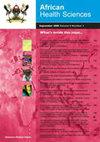尼日利亚南部一家三级医院产前参加者丙型肝炎感染的流行率和预测因素
IF 0.9
4区 医学
Q3 MEDICINE, GENERAL & INTERNAL
引用次数: 0
摘要
背景:与妊娠相关的丙型肝炎病毒感染一直是一种被忽视的疾病,因此,由于母体感染的长期并发症风险、感染对妊娠的潜在影响以及垂直传播给新生儿的风险,因此在妊娠期对其进行识别和治疗具有重要意义。 目的:了解妊娠妇女感染丙型肝炎血清学标志物的比例,确定其危险因素及预测其感染发生的因素。 方法:在为期3周的时间内,对尼日利亚Uyo大学教学医院456名孕妇的血液样本进行了丙型肝炎病毒抗体评估,同时使用预测试问卷来获取社会人口统计数据和危险因素的存在。结果:妊娠期HCV感染率为4.6%。未发现妊娠期HCV感染的已知危险因素。在这项研究中,只有增加胎龄是妊娠期HCV感染的预测因子。 结论:研究人群肝炎病毒感染率较高。妊娠中期和妊娠加重对妊娠期感染有保护作用。因此,有必要对所有前来产前保健的孕妇进行常规筛查。关键词:丙型肝炎病毒感染;孕妇;Uyo;丙型肝炎患病率。本文章由计算机程序翻译,如有差异,请以英文原文为准。
Prevalence and predictors of hepatitis C infection among antenatal attendees in a tertiary hospital in Southern Nigeria
Background: Hepatitis C virus infection as it specifically relates to pregnancy has been a neglected condition, thus its recognitionand treatment in pregnancy is relevant because of the risks of the long-term complications of the infection in the mother,potential effects of the infection on the pregnancy and risk of vertical transmission to the newborn.
Objectives: To determine the proportion of pregnant women with serologic markers of hepatitis C infection, identify risk factorsas well as factors that predict the occurrence of the infection in them.
Methodology: Over a 3-week period, blood samples from 456 pregnant women were assessed for antibodies to hepatitis Cvirus, while a pre-tested questionnaire was used to obtain socio-demographic data and the presence of risk factors in the Universityof Uyo Teaching Hospital, Nigeria.
Results: The prevalence of HCV infection in pregnancy was 4.6%. No known risk factors for HCV infection in pregnancy wereidentified. Only increasing gestational age was a predictor of HCV infection in pregnancy in the study.
Conclusion: The prevalence of hepatitis virus infection among the study population was high. Second trimester and increasinggravidity were protective of the infection in pregnancy. There is therefore need for introduction of general routine screening ofall pregnant women presenting for antenatal care.
Keywords: Hepatitis C virus infection; pregnant women; Uyo; prevalence of hepatitis C.
求助全文
通过发布文献求助,成功后即可免费获取论文全文。
去求助
来源期刊

African Health Sciences
MEDICINE, GENERAL & INTERNAL-
CiteScore
2.30
自引率
0.00%
发文量
179
审稿时长
>12 weeks
期刊介绍:
The African Health Sciences is an internationally refereed journal publishing original articles on research, clinical practice, public health, policy, planning, implementation and evaluation, in the health and related sciences relevant to Africa and the tropics. Its objectives are to: Advocate for and promote the growth of reading culture in sub Saharan Africa; Provide a high quality journal in which health and policy and other researchers and practitioners in the region can and world wide, can publish their work; Promote relevant health system research and publication in the region including alternative means of health care financing, the burden of and solution of health problems in marginalized urban and rural communities amongst the displaced and others affected by conflict; Promote research and the systematic collection and collation and publication of data on diseases and conditions of equity and influence; Promote development of evidence-based policies and guidelines for clinical, public health and other practitioners. African Health Sciences acknowledges support provided by the African Health Journals Partnership Project that is funded by the US National Institutes of Health (through the National Library of Medicine and the Fogarty International Center) and facilitated by the Council of Science Editors.
 求助内容:
求助内容: 应助结果提醒方式:
应助结果提醒方式:


